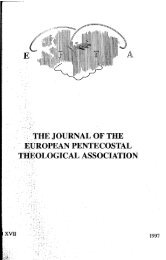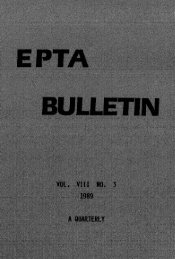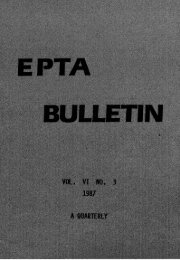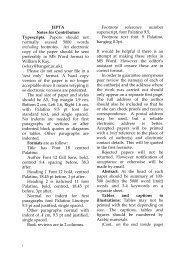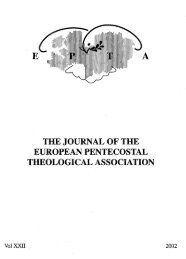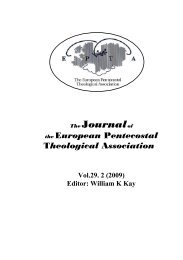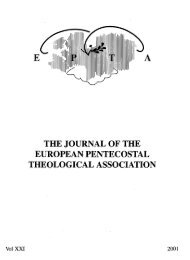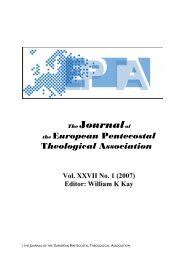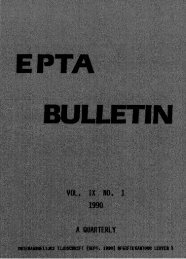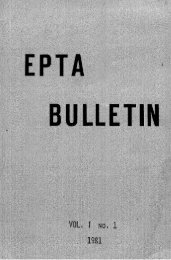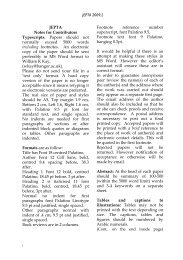jepta 1987 06-1 - European Pentecostal Theological Association
jepta 1987 06-1 - European Pentecostal Theological Association
jepta 1987 06-1 - European Pentecostal Theological Association
You also want an ePaper? Increase the reach of your titles
YUMPU automatically turns print PDFs into web optimized ePapers that Google loves.
EPPA BULLETI N<br />
BULLETIN OF THE<br />
EUROPEAN<br />
PENTECOSTAL<br />
THEOLOG I CAC<br />
ASSOCIATION<br />
VOL VI NO, 1<br />
<strong>1987</strong>
P , ART1 CLE<br />
HOW Public are Public Testimonies?<br />
A Short Reflection on a Liturgical Practice<br />
by Jean-Daniel PlUss<br />
Many of the free churches of the pietistic<br />
tradition are acquainted with the practice of testifying<br />
at public meetings. <strong>Pentecostal</strong>s from their beginning<br />
have been very conscious of the impact personal<br />
testimonies can have on church life in general and on<br />
missionary activity in particular. They understand a<br />
. witness to the power of the Moly Spirit to be a christian<br />
mandate to the world (~cts 1:B). It is therefore not<br />
surprising that early pentecostal publications were<br />
careful to underline any aspect demonstrating the public<br />
and accessible nature of religious experience.(l)<br />
The logic for bringing an intimate experience of<br />
the Transcendent to the market place of opinions is, as<br />
such, easy to formulate. <strong>Theological</strong>ly, the grace of God<br />
is recognized as a free and priceless gift which compels<br />
the witness to share its descriptian for the benefit of<br />
all, and also in order that he can come to terms with his<br />
own impressions. In other words, the public sharing of a<br />
testimony can be understood as the hermeneutic response<br />
to an experience which the believer ideally knows to have<br />
its roots outside himself, Furthermore, it seems<br />
inconceivable to think of a non-public testimony, The<br />
question, though, arises whether or not public telling<br />
automatically leads to public understanding. What should<br />
be public by nature is not necessarily public in<br />
practice. Three aspects of the testimonial practice need<br />
to be considered specifically if the queation of the<br />
title is to be answered. Theae aspects focus on the<br />
communicative triangle consisting of the sender, the<br />
message, and the receiver. The first aspect can be<br />
formulated in the following question: How true is the<br />
witness to himself? More specifically, in what way can<br />
self-deception interfere with the contents of the<br />
narration? The second aspect concerns the question, how.<br />
can the use of language promote or hinder the understanding<br />
of religious values. Are certain language games<br />
unable to qualify for public consumption? And the third<br />
aspect to be examined is the role of the audience. What<br />
does llpublicityll imply?<br />
The Problem of self-~sce~tion<br />
Probably the easiest criteria for the discoverv of<br />
self-deception in testimonial narratives is the<br />
"Who speaks?" The testimony as such speaks for itself. It<br />
is through 'Ithe irruption of something higher" that the<br />
witness feels compelled to testify. If the witness<br />
intends to speak through his testimony then he brings a<br />
foreign element into khe narrative. As Raimundo PANIKKAR<br />
puts it,<br />
I do not bear witness to the truth of my faith if I<br />
proclaim it in order to be a witness . . . O f<br />
course falsehood is alao possible here, As long as<br />
the audience believes the teatimony of the witness,<br />
he bears true witness - ex opere operantis - but he<br />
ceases to do so when the audience discovers that he<br />
- rather than the testimony itself - intends to<br />
speak, to bear witness. In fact, the w i l l to bear<br />
witness implies wanting to show . . . to convert<br />
him because I myself am convinced that the contents<br />
of my testimony are proper for him too . . . the<br />
purpose is no longer the passive blossoming of a<br />
grace that the audience freely discovers, but the<br />
active communication of a value . . . (2)<br />
The winning force of a spontaneous testimony is not<br />
problematic, buk the pre-meditated proclamation in the<br />
disguise of a intuitive telling poses difficulties,<br />
Interprstative comments are therefore rare in spontaneous<br />
testimonies. If they are present, they indicate that the<br />
witness has already passed a pre-reflective stage, for<br />
instance, by virtue of having testified to the same
experience on several occasions, or by their transmission<br />
to writing. Nota bene: interpretative comments do not<br />
invalidate a testimony, but they make a critical reading<br />
more important.<br />
The question "Who speaks?" can shed more light on<br />
inauthentic testimonies of grace from another angle,<br />
namely in the form in which it relates to a thir'd party,<br />
as the Latin roots testis and tri-stans already Indicate.<br />
A testimony is not a dialectical activity between two<br />
parties, rather it is a witness to transcendence which<br />
may be religious or simply institutional as in the<br />
practice of oath .taking. Now if the witness does not<br />
admit the existence of a third party, then the<br />
possibility of self-deception is very real. Alphonse De<br />
WAELHENS gives, from a psychoanalytic viewpoint, two<br />
examples where triple inter-subjectivity is thwarted.(3)<br />
The first case applies to the schizophrenic person, for<br />
whom there cannot be an address to a third person, due to<br />
the difficulties of already speaking as a self.(4) The<br />
second example applies to the paranoiac for whom the<br />
third party is his own self, for he remains psychologically<br />
at the mirror-stage and reacts aggressively to<br />
any deviation of his perception of himself. If asked who<br />
speaks, he would answer "Me, who elselft For him that<br />
means that all truth is his truth. In testifying he<br />
actually makes apodictic statements in which any form of<br />
ambiguity is excluded.(5) But it is ambiguity that<br />
characterizes testimony and bestows unpretentious power<br />
to its speech. After all, to testify is to be involved in<br />
an act of faith. Signs of ambiguity refer to the<br />
awareness of the third party. Phrases like "1 asked<br />
myself,tt "I wondered," or I t i t dawned on mett are typical<br />
pointers to such inter-subjectivity.<br />
It is generally assumed that testimonies<br />
emphatically claim only one interpretation of truth. That<br />
this is not the case is illustrated by the early<br />
pentecostal testimonies of healing in which the medical<br />
profession stands in an ambivalent position. On the one<br />
hand, the real physician is Jesus, on the other hand<br />
medical terminology is used to describe the worsening of<br />
the initial situation and doctors are invited ta verify<br />
miraculous healings. (6) Indeed such testimonies are not<br />
incoherent, but reflect the divided character of human<br />
existence and the delicate enterprise of placing moral<br />
commitment between strongly held beliefs and constantly<br />
emerging model8 with new formulations of what is held to<br />
be true. It follows that the function of testimony for<br />
the Itmapping of a life worldtt fulfills a pivotal role<br />
especially in a secular and pluralist society. As a<br />
conclusion it can be suggested that the ambivalent<br />
character of a testimony, if it is shared in a public<br />
context and is open ,to a public critique, can lend<br />
veracity to the act of communicating a religious<br />
experience. Ambiguity and truth are not necessarily<br />
diametrically opposed,<br />
The Problem of Language Use<br />
If a testimony is truly communicated publicly, it<br />
w i l l he expressed in a language game understandable to<br />
all. It Is not so easy to do so for at least two reasons.<br />
First, a religious experience always evolves around a<br />
disclosure that reveals a surplus of meaning. <strong>Theological</strong>ly,<br />
khis can be described as a disclosure of<br />
grace, The witness testifies to an event that enlarged<br />
his horizon of understanding . Linguistically, such an<br />
experience is described poetically. (7) The insight gained<br />
cannot ho rlescrlhed in a flatly descriptive way.<br />
Metaphors are used as illustrations of that which seems<br />
odd but true.(R) From a positive paint of view there is<br />
a universally ncknowledged and commonly understood way of<br />
expresrslng the religious, It takes the form of<br />
narratives, The bnuic structure of a narrative with its<br />
plot, tensions, and resolutions can be understood by<br />
everyone. Xt i~ no accident that the Christian Gospel is<br />
essentially a nt;ary. If a testimony is truly public it<br />
w l l l mo~t I tkely t;ake the form of a narrative. From a<br />
negakive point; of' vltsw, tho use of poetic language for
describing disclosures of the transcendent can lead to<br />
the well-known problems evolving around "God-talk." This<br />
leads us to the second problem of language use.<br />
The secularization of western society has brought<br />
about a separation between religious language and the<br />
language of common use. Whereas in the Middle Ages the<br />
world view was governed by all embracing religious<br />
convictions, the man of the twentieth century differentiates,<br />
for example, between scientific, social, and<br />
private views. In other words the witness can no longer<br />
take it for granted that formerly common religious lingo<br />
is still being understood. In its form, a testimony can<br />
sound like a "category mistake" when human questions are<br />
met in terms of a transcendent reference, that is, when<br />
an (apparently) non-religious question is answered<br />
religiously. What should be avoided, therefore, is an<br />
unintelligible leap from one language game (and the human<br />
experiences it describes) to another. Edward<br />
SCHILLEBEECKX states:<br />
The missionary task of christianity and the<br />
transition from non-christian to christian thus<br />
confront us with the need for an explicitly<br />
non-religious context of experience within which it<br />
Is possible to listen meaningfully to christian<br />
talk about God in a secularized world.(9)<br />
In one sense this radical statement clearly suggests to<br />
contextualize faith to an experience of meaning, and that<br />
this correlation has to be so fundamental as to be<br />
accessible to all human questions relating to the meaning<br />
of life. The narrative and everyday character of<br />
testimonies seems suitable in this respect, as long as<br />
testimonies do not hide behind a wall of religious<br />
stereotypes. A statement like, "The Lamb of God brought<br />
me to the foot of Golgotha," can hardly be described as<br />
publicly accessible, but the simple story how faith in<br />
God through the example of Jesus changes one's own life<br />
might be understandable. In summary, the message<br />
conveyed, as the second element of the communicative<br />
triangle, can only be of public value to the extent that<br />
it is presented in an accessible code,<br />
What are the Claims of the Audience?<br />
A testimony is by definition addressed to an<br />
audience. It follows that the receivers of the<br />
testimonial message are endowed with an active<br />
communicative role. They are expected to respond as a<br />
sign that the message has been understood. In order to<br />
ascertain the dialogue between sender and receiver a<br />
twofold pact needs to be made if the testimony is to be<br />
truly public.<br />
The first has been called the "autobiographical<br />
act, l1 (10) In an autobiographical communication (as in a<br />
testimony) there is, according to Philippe LEJEUNE, a<br />
generally agreed upon iden'tity between the author and the<br />
narrator, as well as between the narrator and the<br />
protagonist of the story. This basic presupposition makes<br />
an autobiographical account meaningful to the public. The<br />
pact is a warrant of truthfulness. Now, what has been<br />
said concerning self-deception makes the elaboration of<br />
the pact necessary; namely, the warrant of truthfulness<br />
provided by the audience, It takes the form of a public<br />
trial, because the notion of trial is semantically<br />
inherent to the notion of testimony,<br />
The one who testifies reports an event, he gives a<br />
narration, Those who hear the witness must decide whether<br />
or not they can believe the veracity of the facts told.<br />
For the witness it is not enough to state what he has<br />
tlseen,ll he must also give account of its truthfulness. As<br />
such, testimony is therefore always at the service of<br />
j udgmenk ,<br />
This trial is charncterized by a party dispute; the<br />
pleading for one opinion against the other is a<br />
phenomsnon of moat human situations. "We cannot claim to<br />
have cer2:al,n?;y but only probability, It writes Paul<br />
RICCOEUR, !land the probable is only pursued through a<br />
struggle of ~pinlon,~~(ll) This is especially the case<br />
with startemenl;s of faith, The critical element of a
trial, however, does not necessarily debunk the<br />
testimony. It may also enhance its value by acclamation.<br />
The testimony receives an exterior dimension through the<br />
.judgment of its hearers, without which it cannot be truly<br />
public, nor do justice as a doxological expression of<br />
belief.<br />
In other words, testimonial , practice in church<br />
should involve the community - for it is a community of<br />
interpretation. The role of the christian community (and<br />
by implication also that of the world) is, negatively, to<br />
question the testimony in view of the witness' life and<br />
the message of the Gospel. (e.g. Does the false testimony<br />
meet the test of conviction?) Positively, the community<br />
can appreciate a testimony if it reflects the ultimate<br />
testimony, that is, the testimony of life and total<br />
commitment of Jesus Christ.<br />
A final remark on the public nature of testimonies<br />
will bring us back to the early days of <strong>Pentecostal</strong>ism.<br />
As the movement took roots in the western world it<br />
proclaimed its new found freedom in Christ across<br />
institutional barriers and in public places because it<br />
could generally not afford its own architecturally<br />
designed church buildings.(12) The testimonies were<br />
shared on truly public grounds such as parks, public<br />
meeting places and factory halls. Although the<br />
<strong>Pentecostal</strong>s religious practice was claimed to be<br />
esoteric, their language of experience (reflecting<br />
various social milieus) was not.<br />
Furthermore, the argument for publicity has also a<br />
biblical reason. William EVERETT puts it like this,<br />
"Biblical faith gives God a specific character and<br />
address. God has a 'dwelling place I described variously<br />
as 'most high, heaven, heavenly kingdom, heavenly court,<br />
or throne. This spatiality may strike sophisticates as<br />
quaint, unless they realize that the biblical authors are<br />
claiming that God dwells in perfect public - a place of<br />
light, of open disclosure, of persuasive truth, of<br />
judgment in the light of all the facts.I1(l3) To this<br />
statement one could add the familiar notion in the Old<br />
Testament of "God's presence dwelling among his people,"<br />
or the New Testament equivalent: Itthe Word became flesh<br />
and dwelt among us, full of grace and truthu (John 1:14).<br />
EVERETT advocates another reason for paying<br />
attention to the public realm.(l4) It arises as a<br />
contrast from the fallen human condition which retreats<br />
into privation, a place of isolation and darkness,<br />
selfish coercion and death. Ironically, the pluralistic<br />
concept of the "publict1 in a secular world becomes a<br />
symbol of wholeness and salvation.<br />
Jean-Daniel PLUESS<br />
Meuelatrasse 45<br />
CH - 8032 Zurich<br />
Endnotes<br />
(1) So for instance in the first issue of the British periodical<br />
Confidence 1,1 (April 1908). pp. 8-10; or in the Swiss journal<br />
-<br />
Die<br />
Verheissung des Vaters 6, 36 (1913), p. 8. Testimonies from various<br />
iocial backgrounds are mentioned and the witnesses are referred to with<br />
full name, occasionally also uith their complete address.<br />
(2) Raimundo PANXKKAR, Myth, Faith and Hermeneutics (New York:<br />
Paulist Press, 1979), p. 249,<br />
(3) Alphonse DE WAELHENS, I1Ambiguftk de la notion de<br />
tlimoignage," in Le thoignage, Enrico CASTELLI ed., (paris: Aubier,<br />
1972), pp. 467-476.<br />
(5) The case of schizophrenia should however not be confused<br />
uith the double aspect: of the self making a testimonial narrative<br />
possible. Paul BROCKELHAfi distinguishes a self which is characterized<br />
in the tsmporal process brought to light in the testimony, and the self<br />
which causes any reflection about it, Tho ability to keep one's<br />
distance from a temporal experience also explains self-deception,<br />
namely the interplay betwcen a deceiving self and a deceived self. A t<br />
the same time it allows awareness of this arocess and a correction OF<br />
ael f-.decep tion. Paul UROCUELMAN, Time and Self. Phenonsnological<br />
Explorations (Oecatur: 1985), pp, 15-16, 82-83.
(5) Alphone DE WAELHENS, Ambiguftk, pp. 470-473. By implication<br />
the objective to Ittell the truth, the whole truth, and nothing but the<br />
truth" is in fact a paranoiac fallacy! Another example of unambiguous<br />
and self-deceptive testimony has been discussed by Stanles HAUERWAS in<br />
an article on Albert SPEERfs autobiography lllnside the Third Reichll in<br />
Truthfulaess and Tragedy: Further Investigations in Christian Ethics,<br />
(Notre Dame: University of Notre Dame Press, 1977), pp. 82-98. HAUERWAS<br />
mentions various reasons for consciously or unconsciously allowing<br />
self-deception in an autobiographical narrative. To give a few examples<br />
the following desires are cited: to stay morally ignorant about a<br />
certain state of affairs, not to spell out certain activities, to<br />
cherish an illusion, to fit a social role. TO illustrate the possible<br />
extent of self-deception HAUERWAS points to SPEER's deliberate<br />
avoidance of the Jewish issue by clinging to the narrative thread that<br />
presented him as HITLERls apolitical architect. SPEER put aesthetics<br />
over ethics and correlated his identity picture to that decision.<br />
(6) To give a few examples from early <strong>Pentecostal</strong>ism: "A<br />
Wonderful Case of Cancer Healing by the Lord," i n Confidence 5,3<br />
(1912), pp. 65f,; "A Girl's Miracle-Cure,tl in Christian Herald (March<br />
7th, 1912), reprinted in Confidence 5,3 (1912)~ pp. 70f.; Ver alle<br />
deine Krankheiten heilt," in Die Verheissung des Vaters 9,11+12 (1916),<br />
pp. 6ff.<br />
(7) For further information see for instance the writings of<br />
Paul RICOEUR, such as, Essays on Biblical Interpretation, Lewis S.<br />
MUDGE, ed., (Philadelphia: Fortress Press, 1974-1980), pp. 73-154; and<br />
The Rule of Metaphor (London: Routledge E Kegan Paul, 1977).<br />
(8) On a theory of disclosure of odd logic cf. Ian T. RAMSEY,<br />
Religious Language: An Empirical Placing of <strong>Theological</strong> Phrases<br />
(London: SCM Press, 1957).<br />
(9) Edward SCHILLEBEECKX, The Understanding of Faith: In terpretation<br />
and Criticism (London: Sheed and Ward. 1974). .. o.<br />
9<br />
160,<br />
(10) Phillipe LEJEUNE, "Le pact autobiographique,~~ in Podtique<br />
14 (1973) 9 pp. 137-162.<br />
(11) Paul RICEUR, Vhe Hermeneutics of Testimony,l in Essays on<br />
Biblical Interpretation, p. 125.<br />
(12) See endnote (1).<br />
(13) William EVERETT, "Liturgy and Ethics: A Response to Saliers<br />
and RamseylH in The Journal of Religious Ethics 7,2 ( 1979)~ p. 209.<br />
(14) William EVERETT, "Liturgy and Ethics," p, 210.<br />
Paul<br />
I I , BOOK REVIEWS<br />
ELBEIIT (ed.), Essays on Apostolic Themes: Studies in<br />
Honor of Howard M. ERVIN presented to him by<br />
Colleagues and Friends on his Sixty-fifth Birthday<br />
(Peabody, MA: Hendrickson Publishers, 1985). . . 239<br />
pp. Reviewed by John KARSTEN, Zeist, ~olland.<br />
Honoring a scholar with a book - a familiar custom<br />
among Germans - is starting among Charismatics and<br />
<strong>Pentecostal</strong>n. This back honors the American scholar and<br />
Pastor H.M. ERVIN who teaches at Oral Roberts University.<br />
A brief story of ERVIN'S life and his bibliography is<br />
included. The contributors come from a wide range of<br />
denominations, including the Assemblies of God and the<br />
Roman Catholic Church.<br />
A brief survey will illustrate the book's value. At<br />
the: level of l~orrneneu'tical presuppositions, William<br />
MENZIES defends the classical pentecostal link between<br />
,[;he I4oly Spirit and tongues while G,A, TURNER briefly<br />
doacribea tho Woly Spirit in the Hermeneutics of the<br />
Iicformation and the Radical Reformation." Strangely<br />
enough, he includes Pietism, Quakerism and Methodism in<br />
which the inner. testimony is the major work of the<br />
Spirit. In HI-lermeneutics; A <strong>Pentecostal</strong> Option," ERVIN<br />
himself opposes demythoLogization and the new hermeneutics.<br />
I-le argues that the miraculous is not mythical<br />
but real and can be experienced today by the Spirit. This<br />
assumptian, he believes, is more realistic than an<br />
accomodation to outmoded materialistic thinking.<br />
F.P. BRUCE writes exhaus'tively on "The Spirit in<br />
the I,,ettcr to tho Ga.latianstl and relates data to other<br />
New Tsstament aogments . The Galatians had received the<br />
Spirit vi~ibl.y and He had produced love and hope, The<br />
promise was given praviously that the judgment started<br />
with Pentecost RO that justification and life in the<br />
Spirit are inseparable. Adoption is not only a change in
status for it implies a relationship to God as Father,<br />
and Jesus as Lord. BRUCE'S consideration of the leading<br />
of the Spirit in moral living and the fruit of Christ's<br />
character concludes a first-rate study.<br />
J .D. G. DUNN in his contribution entitled "Romans<br />
7:14-25 in the Theology of Paultt argues forcefully and<br />
with broad documentation that this position describes<br />
Paul's present christian life. Those contending for<br />
other views (e.g. that the passage refers to Paul's<br />
pre-christian life, or the majority view that it refers<br />
to men apart from Christ as viewed by a believer) will<br />
need to take note of his arguments. H.R. YIM has his<br />
focus on "Preaching God's Word in Demonstration of the<br />
Spirit and of Power.I1 He argues that effective preaching<br />
requires the centrality of the Bible and the ministry of<br />
the Holy Spirit and that the goal of preaching is<br />
liberating people although the context in which preaching<br />
occurs can vary.<br />
J. HORNER relates "The Holy Spirit and the Wisdom<br />
of God," while J. REA examines "The Personal Relationship<br />
of Old Testament Believers to the Holy Spirit,"<br />
concluding that Old Testament believers were regenerated,<br />
but not permanently indwelt by the Spirit, Temporary<br />
endowment for tasks did occur, but only just before<br />
Christts ascension was the Spirit finally given. C,M.<br />
ROBECK, Jr. shows that IRENAEUS, the second century<br />
bishop of Lyons, was acquainted with charismatic<br />
phenomena not only in Gnostic and Montanist settings, but<br />
also in orthodox churches, for prophecy was apparently<br />
part of normal church life.<br />
The editor of this volume, Paul ELBERT, discusses<br />
sympathetically and broadly llCalvin and the Spiritual<br />
Gifts." It is common knowledge that CALVIN considered the<br />
visible gifts to have ceased in apostolic times, yet he<br />
recognized graces and ministries in the Church. Some<br />
"restoration pastors" now follow CALVIN possibly without<br />
knowing it. G. STRACHAN proves his grasp of the<br />
It<strong>Theological</strong> and Cultural Origins of the Nineteenth<br />
Century <strong>Pentecostal</strong> Movement." This movement started<br />
among the cultured members under influence of new<br />
cultural impulses which uncovered old biblical truths<br />
Such as the uni~ersal love of God, the humanity of Christ<br />
which overcame through the Spirit, and the pattern of the<br />
early church.<br />
<strong>European</strong> topics are discussed by Ivar LUNDGRAN, who<br />
describes briefly I1Lewi PETHRUS and the Swedish<br />
<strong>Pentecostal</strong> Movement. Although the description is brief<br />
the author is successful in his task. L. GOTT introduces<br />
ttDonald GEE: The Apostle of Balance" as he describes the<br />
man who excelled as a Bible teacher, writer and educator.<br />
I-lis involvement with Bible school work should be well<br />
known, for he stated that he ftshould like to make it<br />
clear that we place no premium upon ignorance and<br />
illiteracy" (p 176). Furthermore, GEE'S stance on<br />
healing and wealth is atill important. J.L. CORNELLY in<br />
his article entitled "Not in the Reputable Churches: The<br />
Reception of the Charismatic Movement in the Mainline<br />
Churches in AmericaM shows that these churches first<br />
opposed the charismatic phenomena claiming that<br />
glossolalia was symptomatic of mental illness, but in the<br />
19701s it came to acceptance, provided certain safe<br />
guard. were strongly maintained. Fundamentalist churches,<br />
nsvertheless, remained opposed, The article concludes<br />
w tth the unexpected findings of GREELEY and McCREALY that<br />
45% of all Americans claim ecstatic experiences,<br />
The Jesuit *D,L. GELPI in his "Ecumenical<br />
Reflections on Christ s Eucharistic Presence" utilizes<br />
his philaeophical. training to relate different underatandings<br />
of communion in LUTHER, CALVIN, and ACQUINAS to<br />
the appropriate philosophical frame of reference. He then<br />
advances nine affirmations which, he hopes could prove<br />
acceptable to all, but of course not all will accept<br />
them, This item is certainly the most original article in<br />
the book. J. AMSTUTZ in "Deyond Pentecogt: A Study of<br />
Some Sociological Dimensions of New Testament Church<br />
Growth from the Book of Actsft examines why the early<br />
Church continued to grow, The reasons he finds are: a<br />
love expressed socially, a conductive structure, the fact
that all believers were active, the expansion of<br />
leadership base, the indigenous nature of the Church and<br />
a sensitivity to culture, its concentration of receptive<br />
people and, finally, the fact that multiplication was<br />
built in. This article is one of the most practical.<br />
Indexes of names and references conclude this<br />
beautifully produced book.<br />
Howard M. ERVIN, Conversion-Initiation and the Baptism in<br />
the Holy Spirit (Peabody, MA: Hendrickson, 1984),<br />
172 pp. Reviewed by David PETTS, Mattersey,<br />
England.<br />
This fine study by Dr. Howard M. ERVIN, who is a<br />
professor at Oral Roberts University, is sub-titled "An<br />
Engaging Critique of James D.G. DUNNts 'Baptism in the<br />
Holy Spirit,tl1 a work which, since its publication in<br />
1970, has been acclaimed by those who oppose a common<br />
pentecostal position. DUNNts conversion-initiation<br />
thesis, . which sees repentance, faith, baptism and the<br />
gift of the Holy Spirit as representing an indivisible<br />
unity without which one is not a Christian, provides the<br />
basis for his rejection of the pentecostal understanding<br />
of the Baptism in the Holy Spirit as an enduement with<br />
power for service received subsequent to regeneration.<br />
ERVIN recognizes DUNN's work as Itone of the most<br />
comprehensive and influential rebuttals of <strong>Pentecostal</strong>ism<br />
todayt1 and systematically tackles DUNN s<br />
conversion-initiation hypothesis chapter by chapter. As a<br />
result the structure of his work is predetermined by that<br />
of DUNN .<br />
Following DUNNt s outline ERVIN deals first with the<br />
John the Baptist references to the Baptism in the Holy<br />
Sprit, then with Jesusf baptism, the Day of Pentecost,<br />
the Samaritans, Paul, Cornelius, and the Ephesian<br />
disciples. Relevant passages in the Epistles of Paul and<br />
the Johannine literature are covered systematically<br />
followed by those in Hebrews and I Peter. The standard<br />
pentecostal understanding of the Baptism in the Holy<br />
Spirit as subsequent to regeneration is defended<br />
throughout and the weaknesses and presuppositions in<br />
DUNNts position are exposed,<br />
Particularly compelling, for example, is ERVIN'S<br />
rejection of DUNNts contention that the Samaritans were<br />
nat yet Christians even though they had believed and been<br />
baptised. By a careful comparison of the use of the verb<br />
pisteuein elsewhere in the NT writings ERVIN skillfully<br />
refutes DUNNts contention that the use of the verb with<br />
the dative indicates only an intellectual acceptance<br />
rather than real commitment.<br />
There are times, however, when one feels that ERVIN<br />
is pressing far too hard for the concept of the<br />
subsequence of the Baptism in the Holy Spirit. This is<br />
particularly evident when he argues that the infilling<br />
recorded in Acts 4:31 was the occasion oithe converts at<br />
Pentecost receiving the Baptism in the Holy Spirit,<br />
though even here the discussion is scholarly if<br />
unconvincing, In this connection it is unfortunate that<br />
ERVIN, along wikh many pentecostal exegetes, falls into<br />
the trap of insisting that the Baptism in the Spirit must<br />
follow regeneration when all that the pentecostal<br />
position logically demands in that it may.<br />
Despite these cautions, however, ERVIN has made a<br />
valuable contribution to pentecostal scholarship and<br />
appears in most cases to have successfully challenged<br />
DUNNts exegesis. However, it is unfortunate that his<br />
style is far less readable than DUNN's and 'despite his<br />
claim to have attempted to minimise the tediousness of<br />
the kind of answer demanded by such a response, one<br />
cannot help but feel that, in this respect at least, he*<br />
has failed. We are, nevertheless, grateful to ERVIN for a<br />
skillful and thorough rebuttal of DUNN s hypothesis. His<br />
work should undoubstedly stand alongside that of DUNN in<br />
every Bible college library.
Ingmar GUSTAFSSON, Bengt SAMUELSSON and Per SUNDBERG,<br />
Nyreligiiisa rijrelser i Svergie: En kort presenta-<br />
- tion Ingmar GUSTAFSSON (ed.), (Stockholm: Normans<br />
Forlag, 1983), 160 pp. Reviewed by David BUNDY,<br />
Lexington, KY; U.S.A.<br />
The study of new religious movements was<br />
traditionally designated the study of "cults. " That term<br />
came to connote condescension and an assumed negative<br />
evaluation. In congruence with the long tradition of<br />
apologetics within the christian tradition, such works<br />
served to convince the convinced that the alternative<br />
traditions were not valid traditions. Such triumphalism,<br />
however, makes for poor scholarship and does not<br />
accomplish its purpose within the church, much less<br />
outside, In highly individualistic western society, the<br />
llcultsll approach is not taken seriously by persons who<br />
have actually come into contact with other, albeit newer,<br />
traditions and have felt the strength of their<br />
commitments and integrity and have recognized the cogency<br />
of their reason.<br />
The present volume by GUSTAFFSON et. al. takes<br />
quite a different approach. The effort is to present, as<br />
accurately and non-prejudicially as possible, the history<br />
and religious philosophy of the various new religious<br />
movements recruiting in contemporary Sweden. The<br />
introductory chapter (pp, 11-16) reveals the personal<br />
commitments of the authors to an established tradition.<br />
They note that the majority of the new movements have<br />
arrived in Sweden from the U.S.A., including most of<br />
those which are originally from East Asia and India. They<br />
also indicate that most groups are rather authoritarian<br />
in their community structures, concerned with security in<br />
the future,<br />
and do not accept the traditional christian<br />
canon and exegesis.<br />
The authors introduce serially the Jehovah's<br />
Witnesses (pp. 17-40) , Mormonism (pp. 41-60) , Baha i (pp,<br />
61-66}, Transcendental Meditation (pp. 67-72), Zen and<br />
other forms of meditation (73-84), Scientology (pp.<br />
85-92), Family of God (Karlekens Famil j ) (pp. 93-loo),<br />
spiritualism (PP. 101-108), Hare Krishna (pp. 109-112),<br />
~heosophy (PP. 113-120 ) , Anthroposophy (121-124), The<br />
unification Church (Tongill (125-131 ) , Eckankar (132-133)<br />
and UFO-ology (pp. 134-136). The method is consistent.<br />
The history of the group and its development are<br />
the teachings of the movement are described,<br />
sources of authority identified, and the organisational<br />
structure delineated, When there are creeds or statements<br />
of faith, these are appended. Extensive bibliography<br />
about each movement i ~ l provided (pp. 137-144). Here as<br />
well., the effort of the writers to be fair is apparent,<br />
After a list of general works on new religious movements,<br />
the bibliography is classified according to movement, In<br />
each case the movement's own literature is presented<br />
first, and then a bibliography of works about the<br />
movement is added. A general index and a separate index<br />
of names facilitate use of the volume as a reference<br />
tool, A study plan, which allows the volume to be used in<br />
church groups or classrooma is appended.<br />
The volume is remarkable for its perspective,<br />
design and for the accuracy of the information presented.<br />
It iu hoped that this work will serve as a model for<br />
other efforts.<br />
Ralph P, MARTIN, The Spirit and the Congregation (Grand<br />
Rapids: Wil.liam B. Eerdmans Publishing Cob , 1984),<br />
vii + 168 pp. Reviewed by Robert A. LOVE, Brussels<br />
Belgium.<br />
A t first glance, The Spiri't and the Congregation<br />
appears to be simply a specialized commentary. To be<br />
sure, it is that. -1t deals successively with the last<br />
four chapters of tho book of First Corinthians.
The underlying purpose of the book, however, is not<br />
merely the exposition of an intrinsically interesting<br />
portion of scripture. The theme is congregational<br />
worship, with all spiritualities, charisms and graces in<br />
operation and under review by apostolic authority,<br />
Each of the chapters is preceded by a transla'tion<br />
of the text to be considered. Such translations, often<br />
presumed to be literal, are occasionally presented as the<br />
capstones of the arguments. In this case, rather the<br />
author provides us with "Points to Ponder.I1 These are<br />
identifications and amplifications of difficult areas,<br />
Reference is made without comment to scholarly opinion.<br />
Of particular interest to the community of modern<br />
day pentecostal believers, whether classical or charismatic,<br />
are the treatments of First Corinthians twelve and<br />
fourteen. It is refreshing that the traditional<br />
evangelical proscriptions are overlooked if not forgotten.<br />
The unsupportable contention that tttongues shall<br />
ceaset1 becomes a positive assertion that there should be,<br />
Itin a public service, a desired blend of the formal and<br />
the intimate that never descends to the level of what is<br />
no better than the casual or even flippant.I1 (p. 64)<br />
The themes of congregational unity and edification<br />
inhere. The author speaks clearly for the broad scope of<br />
gifts. MARTIN identifies twenty gifts of God in the New<br />
Testament literature. The nine selected for mention in I<br />
Corinthians were Paul's choice based on the situation at<br />
Corinth. In response to this situation a call is issued<br />
for order and a disciplined way of conducting worship. As<br />
onerous as it may seem there should be control: the<br />
control of the Spirit, self-control of the believers, and<br />
as necessary, the more formal control of leadership. Paul<br />
opposed Itthe Corinthians1 desire to turn the church into<br />
a Gnostic conventicle of private individuals, each<br />
concerned with his or her own inalienable experiences and<br />
heedless of the corporate dimension ..,I1 (D. .-<br />
62)<br />
The Spirit and the Congregation offers interesting<br />
- even fascinating - alternative explanations for a<br />
number of interpretations which have been canonized by<br />
the classicists of many camps. For example, Paul enjoins<br />
the Corinthians not to forbid speaking in tongues<br />
(14:39). The standard pentecostal/ charismatic approach<br />
is to refrain gingerly from any discouragement of the<br />
of 'this gift except under all but the most<br />
extreme of circumstances. Othera take the view that<br />
tongues are by no mean8 forbidden. "Let them,I1 they say,<br />
tigo to the pentacostal church and do it.!! MARTIN points,<br />
however, that there is more than one activity which<br />
passes under this rubric: These are llhottl tongues which<br />
border on frenzy, and ttcoollt tongues which can be<br />
restrained (p. 67). Indeed, it is held that the statement<br />
Itnot all speak with tonguestt (12:30) is explained by this<br />
disti.nction which Paul makes. It is the controllable<br />
variety of tongues which Paul practices and encourages in<br />
others.<br />
The distinguishing of the roles of men and women in<br />
corporate worship is another of MARTIN'S creative<br />
alternatives. There is little doubt that there was at<br />
least; a local problem with the behaviour of the<br />
Corinthian women. This resulted in their identification<br />
as disturbere of the service and the placing of certain<br />
restrictions on their participation. Can we from this<br />
infer that a1.l wamen, everywhere and for all the time,<br />
should be in silence and subjection? Certainly not. The<br />
subjection to which Paul refers is nok to their husbands<br />
but rather ta their own spirits or to the body, Indeed,<br />
the prohibition of women teaching results, in MARTINIS<br />
thinking, not from any intrinsic inferiority of women but<br />
rather from Ittheir wrongful aspiration to charismatic<br />
teachers, Ispenking in inspired languages and laying<br />
clafm to introduce fresh revelations that they were not<br />
willing to have assessed and corrected by the assembly<br />
and in accord with aposto1.i~ standards.I1 (p. 87)<br />
One can hardly refrain from comparing The Spirit<br />
and ,the Congregation with the anti-pentecostal polemics<br />
of a generation or two ago, Ralph MARTIN does not lay<br />
down his pen to bellow and to paw the earth. Rather, we<br />
can picture him smiling or even laughing as he writes.
There are many types of laughter. There is the<br />
laughter which exults over the imperfections of others<br />
and which hardly qualifies as laughter at all. There is<br />
the laughter of friends who share the humor of the<br />
unanticipated of the inconsistent. There is also that<br />
laughter of the one who sees an inconsistency first and<br />
enjoys the dawning perception of the other. This most<br />
gentle of all forms of humor begins within and makes its<br />
way to the surface. Often, a smile is all that remains.<br />
The Spirit and the Congregation does indeed contain<br />
within its scholarly pages that latest from of laughter,<br />
Its source is, as it were, between the lines and speaks<br />
to those who all too readily maintain that all should be<br />
Charismatics. "Ah! " it says, "You see it now. Take care<br />
that you do not lose the mystery of God and your<br />
perception of the body and, in so doing, become merely<br />
spiritual . I '<br />
Carl Erik SANLBERG, The <strong>Pentecostal</strong> Movement - Five Case<br />
Studies (Nairobi: no publisher given, but printed<br />
by Evangel Publishing House, 1985), 69 pp, Reviewed<br />
by Peter HOCKEN, Gaithsrsburg, Maryland, U.S.A.<br />
SHALBERG is a Swedish Lutheran pastor, whose<br />
doctoral dissertation at Upps~la in 1977 was on the<br />
Swedish <strong>Pentecostal</strong> movement and its daily newspaper<br />
Dagen. Since 1983, he has taught church history at<br />
Makumira Lutheran <strong>Theological</strong> College in Tanzania.<br />
This booklet gathers five studies on the<br />
<strong>Pentecostal</strong> movement presented at Makumira. A11 present<br />
an historical account of the evolution from the earliest<br />
stages of the <strong>Pentecostal</strong> movement through the phases of<br />
expansion to those of wider acceptance.<br />
The first study<br />
concerns the attitudes of scholars to <strong>Pentecostal</strong>ism (a<br />
version of this has been published in Evangelical Review<br />
of, January 1985, pp. 70-77) , the rest deal with<br />
the practices and beliefs of <strong>Pentecostal</strong>s: the roles of<br />
the Father and of the Son; attitudes toward political and<br />
involvement; attitudes to medicine and healing;<br />
the: pentecostal missions in Tanzania. The strong points<br />
of these studies are SAHLBERG1s feel far what is<br />
significant, his breadth of interest and of awareness and<br />
his ability to mduce complex data to managable<br />
proportions without distortion. The historical evolution<br />
is presented critically yet sympathetically, avoiding the<br />
two extremes of seeing the movement's history as either<br />
steady decline from pristine glory or as sectarian<br />
fanatics gradually becoming more reasonable. There is<br />
much interesting information in these studies, some of it<br />
not easily accessible elsewhere in English, especially<br />
the parts relating to Scandinavia and to Tanzania. He has<br />
a number of pertinent observations, e .g. "The <strong>Pentecostal</strong><br />
churches of the Third World also keep a more original<br />
eschatological perspective alivevv (p. 30) and "It is no<br />
coincidence that in the country which is considered to be<br />
the most dechristianiz;ed in this Western Europe, namely<br />
Sweden, the first; political party in the world with<br />
pentecouta1.s a8 t;he core shou1.d also ba founded,I1 (p, 32)<br />
Also worth noting nro remarks on early pentecostal .<br />
attitudes to illness aB lacking in any reflection on the<br />
phenomenon of suffering (pp. 39-41).<br />
Thc weakness of these studies is primarily in the<br />
intelligibility of the Engli~h, which must be worse than<br />
the author imagines, and in the carelessness of the use<br />
of source material, which can only partly be due to the<br />
difficulties of writing pentecostal history in a country<br />
with lesser Library facilities, The errors are numerous,<br />
though they @re generally incidental and do not vitiate<br />
the arguments of the studies, Charles W. CONN is referred<br />
to ns Chaileo W. CANNS (p. 6) ; the charismatic renewal is<br />
described as being "born in a univer~ity milieu1' (p. 71,<br />
presum~lbly an attribution of the 1al;er start among<br />
Catholics to the whole movement; James BARR's book<br />
Fundnmentalisrn is mentioned as ~undamental~ (p, 311, and<br />
the plural of homo politicus is wrongly given as homini<br />
'
politici (pp. 3Of. ) ; ttIntercessors for Americatt is<br />
described as being established in about 35 countries,<br />
instead of ttIntercessors for Britaintt, etc. (p. 33) ; the<br />
Assemblies of God in the USA is said to have been "more<br />
closely reorganized in 1914" (p. 51). It is to be hoped<br />
that Dr. SAHLBERG will pursue his historical -<br />
theological reflections on the <strong>Pentecostal</strong> movement, but<br />
that the accuracy of the English and the references will<br />
be significantly improved.<br />
Robert L. YOUNGBLOOD ( ed. ) , Cyprus : TEE Come of Age<br />
(Exeter:: Paternoster Press for the World Evangelical<br />
Fellowship and the International Council of<br />
Accrediting Agencies, 1986), 78 pp. Reviewed by<br />
Donald Dean SMEETON, Rhode St. Genese, Belgium.<br />
Critical self-assessment is characteristic of the<br />
progress toward maturity. The willingness to identify<br />
strengths and acknowledge failures can also contribute to<br />
improvement and self-reliance. It is thus fitting that<br />
<strong>Theological</strong> Education by Extension (TEE), which was<br />
birthed at the Evangelical Presbyterian Seminary two<br />
decades ago, should evidence these signs of having come<br />
of age. self-criticism characterizes this modest volume,<br />
which contains the three major papers presented at a<br />
consultation on TEE sponsored by the International<br />
Council of Accrediting Agencies and the <strong>Theological</strong><br />
Commission of the World Evangelical Fellowship held<br />
during July 1984 in Cyprus.<br />
TEE has outgrown the impertinent exuberance of its<br />
adolescence and its impatience with the traditional<br />
establishment of theological education. Its early<br />
promises included the rejuvenation of educational<br />
structures as well as the renewal of church life. TEE,<br />
with its pattern of independent study punctuated by<br />
periodic classes, promised to bring the school to the<br />
~tudent and to eliminate the elitist mentality that<br />
seemed to dominate theological education. The traditional<br />
pattern of theological education was judged to be<br />
theoretical., irrelevant, and isolated from cultural<br />
realities. TEE seemed to be the only reasonable option<br />
for those parts of the world where Christianity was<br />
rapid ~u~erical growth and where leadership<br />
not be severed for a period of four or more years<br />
of theological formation on the western model in<br />
isolation from the student's own community. TEE was<br />
considered the perfect answer to the needs, for it wag<br />
formed in the matrix of church growth, missiology, and<br />
theological education.<br />
TEE branched from its Latin ~merickn beginnings to<br />
take root in virtually every continent. TEE has<br />
mushroomed from the first attempts at small step<br />
programed learning, to the copious variety of adaptions of<br />
culture and language, The bandwagon was boarded by a<br />
large number of denominational, interdenominational, and<br />
non-denominational educational organizations. Some<br />
programs have been concerned only with ministerial<br />
training while others have broadened to include the<br />
training of lay 1.eadership in the local church. Even<br />
though TEE has challenged traditional assump tions and<br />
created many new structures, the educational literature<br />
has not kept; pace with these developments. Ross F.<br />
KINSLER has documented Rome of the variety and character<br />
of these programs by his Ministry by the People<br />
(Maryknoll: Orbia Books, l983), but his study is<br />
descriptive and ilXustrative rather than analytical. The<br />
number and variety of TEE programs defies any attempts at<br />
forming a comprehensive listing. As the manifestations of<br />
TEE have multiplied, however, so have its weaknesses.<br />
Although TEE has had considerable success, it has not<br />
achieved ita full promiss, This is precisely why the work<br />
by YOUNGBLOOD is so important, It appears that even some<br />
of the practices that were once judged so harshly now
seem to characterize the TEE structures themselves.<br />
The<br />
message seems to be that TEE may have come of age,<br />
but it<br />
-<br />
has not yet arrived.<br />
As ..-<br />
often happens with the publication of conference<br />
papers, this collection suffers from variety in style,<br />
content and documentation, But even after one makes the<br />
predictable comments about unevenness, there ie an<br />
important logical continuity that binds these studies<br />
together by covering the past, present and future. Each<br />
essay was prepared by an educator with broad experience<br />
in distance education programs in a developing nation.<br />
Each contribution is permeated with practical insights<br />
and personal commitment. Each has its own significance.<br />
. A summasv of the history of TEE is sketched by<br />
Kenneth MULHOL~AND whose fluid style is interrupted by<br />
his over-fondness for citing authorities, especially<br />
himself! This essay is, however, more than a history<br />
lesson for MULHOLLAND does not; hesitate to draw lessons<br />
from history by listing TEE'S achievements and failures,<br />
Next Lois McKENNEY, who pioneered cooperative work among<br />
the TEE programs in Brazil, appeals for interaction among<br />
TEE programs, residential schools, accrediting agencies<br />
and other educational entities. Articulate appeals even<br />
when linked with practical suggestions are, however,<br />
easier to make than to implement and her essay suffers<br />
from a lack of the documentation which she could so<br />
easily have added. In another chapter, Robert FERRIS<br />
analyzes the educational psychologies of Paulo FREIRE,<br />
Jean PIAGET, Robert CARKHUFF, Arthur COMBS and Malcolm<br />
KNOWLES, then offers suggestions for the application of<br />
these theories to theological education. He identifies<br />
what he believes should be the essential and controlling<br />
values for future developments of TEE. I-ie concludes that<br />
whatever new patterns develop they must be centered in<br />
experience, grounded in servanthood, and committed to the<br />
need for continued improvement. In keeping with these<br />
needs, Randall BELL contributes a final chapter on<br />
"Institutional Self-Evaluation in Bible Colleges."<br />
Although this document has its origins in the American<br />
accrediting system Was not part of the Cyprus<br />
meeting, it forms a natural sequence to the concept of<br />
self-criticism which is essential to the improvement of<br />
any educational system.<br />
TEE is characteristically, but not exclusively, the<br />
genius of Evangelicalism with its camrnitments<br />
to b~ing<br />
every Christinn to full maturity. It has brought training<br />
to those in tho pulpit as well. as those in the pew who<br />
otherwise would be denied the opportunity of a<br />
theal.ogicnl education. The TEE concepts and techniques,<br />
however, have influenced a wide variety of other<br />
educational programs, Rome evcn outside the discipline of<br />
theology, This influence explains why these essays demand<br />
attention from all who work in decentralized programs or<br />
seek to irnplemen'k distance education structures. The<br />
biblio~rnphien increase the book's usefulness as a<br />
starting point to understanding TIYE, This work may not be<br />
the definitive otudy, but it 1s an important analysis.<br />
IT I , NOTES<br />
C.S. BUTLER, Te5t the Spirits: An Examination of the<br />
Charismatic Movemsnt (Welwyn, Merta: Evangelical<br />
Press, 1985). 156 pp.<br />
Of all the hundredfl of book8 on the <strong>Pentecostal</strong> and<br />
Charismatic movement that X have read this one must rank<br />
as one of the wormt, The publiaherls blurb speaks of the<br />
author's "wealth of experience from within the<br />
charismatic movement. This is contradicted by his own<br />
testimony - which i~ held over until page 124. Me appears<br />
to have tried almost everything. How long he maintains<br />
his position remains to be seen.<br />
The standard of scholarship in this volume is of a<br />
low order. Most of the details are borrowed from<br />
sccondnry sources, There are serious works which question
pentecostal theology and practice (i.e, BRUNNER, DUNN,<br />
and HOEKEMA) but these are ignored, perhaps because the<br />
author considered them too sophisticated, The publishers<br />
have tarnished their good name by such a production. The<br />
book is trivial. The chapter on gifts in the New<br />
Testament contains less than 500 words. Whole groups are<br />
dismissed with a flick of the pen. For example, to write<br />
of David BERG and the Children of God as charismatic is a<br />
travesty.<br />
If it is true as the author claims - and this is<br />
one of the few things in this book with which I would<br />
agree - that there is a growing acceptance of charismatic<br />
practice among some evangelicals" (p. 62), this book will<br />
do nothing to stem the tide. <strong>Pentecostal</strong>/charismatic<br />
theology and practice are open to examination. Some<br />
things that have been done are not above criticism, but<br />
this book will only confirm the prejudices of those whose<br />
minds are already closed and will cause unnecessary<br />
offence to others.<br />
and numerous christian services. The book<br />
ranges from animal welfare organizations to an article by<br />
Jim HOLWAY on Mosque attendance,<br />
Yet; it itit more than a data base on Christian<br />
trivia: it is a revealing study of trends and a pmgnosticator<br />
of the future. For example, the table on page<br />
142 shows that the list of Elim ministers increased from<br />
152 in 1980 'to 403 in 1985. This change represents an<br />
increase of 21% Per m'mum but the number of churches<br />
increased only Q.8% per amurn during the same period, One<br />
can easily sea that this kind of information is essential<br />
for long range plnnning for this group of pentecostal<br />
churches.<br />
In addition the collection of data, the editor<br />
offers an assessment of trends affecting Christianity in<br />
the UK. Ma describes 1) the nature of the post-christian<br />
era, 2) the increasing frngmentation, 3) more polarization,<br />
4) the challenges to leadership, 5) a decreasing<br />
nominalism, 6) the irrelevance of denominational labels,<br />
and 7) the expectations of growth.<br />
Peter BRIERLEY (ed.), UK Christian Handbook <strong>1987</strong>/88<br />
Edition (Bromley , Kent: MARC Europe; London:<br />
Evangelical Alliance; Swindon, Wilts: Bible<br />
Society, 1986), 649 pp.<br />
Do you need to find a christian children's home in<br />
Kent? Or, the telephone number of the headquarters in<br />
London of the Prayer Book Society? Or, a complete list of<br />
all the christian periodicals published in the UK? Or how<br />
to compare the charges of all the anglican theological<br />
colleges? A l l of these answers - and many, many more -<br />
are accessible in this one convenient resource. It<br />
contains listing (with relevant information) on accomodations,<br />
bookshops, churches, educational institutions,<br />
leadership resources, media ministries, missionary<br />
Walter J, HOLJJiNWEGER and S, CARREL, "Le dernier repas:<br />
une liturgie eucl~aristi.que narrative et tht5atrale,lq<br />
Hokhma, 32 (1986), 1-21.<br />
Thia article consists of four parts and provides a<br />
general introduction to H0LLENWEGERt8 theological methodology.<br />
The firfjt part surveys his academic and<br />
ministerial back~round while the second provides a<br />
theological profile, The third presents a drama that<br />
interprets the rite of the Lord's Supper for the particip~nts<br />
and, final.ly, the article closes with a partial<br />
listing of I-IOL1,ENWEGER '8 publications. The authors see<br />
the tradi,tional pr0testnn.t churche~ as much concerned<br />
with hermenewtical reflection on *the biblical texts and<br />
not interested enough in the intercultural proclamation
of the Gospel. Too often their western orientation has<br />
led to division. Faced with this situation, HOLLENWEGER<br />
pleads for an emphasis on picture, story and narrative in<br />
communicating spiritual reality. He also calls for a reevaluation<br />
of the physical aspects of religion including<br />
emotion.<br />
D.D.S.<br />
Marc H. SPINDLER , ttEurope s Neo-Paganism : A Perverse<br />
Inculturation," International Bulletin of Missionary<br />
Research, 11,l (January <strong>1987</strong>), 8-11,<br />
Marc SPINDLER of the University of Leiden traces<br />
the historical background and the importance of Europe's<br />
neo-pagans. He maintains that although this phenomena has<br />
political overtones, it is primarily a religious<br />
movement. We sees the main features of this religion to<br />
be 1) the affirmation of the sacred, against the<br />
desacralization of the universe so that there is no<br />
distance between God and the world; 2) the exaltation of<br />
the vitality and joy of natural human life (in such a way<br />
that eros is separated from agape); 3) the recognition of<br />
fate as a ruling force in human affairs; and 4) the<br />
stress on its claim to cultural identity. This view<br />
features faith in a cosmic beginning and cyclical view of<br />
history. For a significant number of people, <strong>European</strong><br />
neo-paganism is an ideology of resistance against global<br />
systems, drawing upon mythical elements in the prechristian<br />
tradition of european cultures. The article<br />
ends with an appeal to the churches to communicate a<br />
gospel that is not obscured, diluted or mutilated.<br />
D.D.S.<br />
David THORP, "Renewing the Face of the Earth,I1 - New<br />
Covenant (February <strong>1987</strong>), 25-27.<br />
This article is one of several in this issue<br />
dedicated to celebrating the twentieth anniversary of the<br />
Catholic Charismatic Renewal. The entire magazine is a<br />
collection of photographs, evaluations, summaries and<br />
comments by or about the leaders of the renewal.<br />
The one contribution chosen for this llnotetv<br />
identifies what the author deems to be the significant<br />
characteristics of the renewal. Furthermore, he relates<br />
them theologj.cally to the Second Vatican Council. This is<br />
natural, for the renewal understands itself as a visible<br />
manifestation of the famous "pente~ostal~~ prayer of Pope<br />
John XXIII. THORP finds six "wonders" that characterize<br />
the Catholic renewal: 1) giving attention to the working<br />
of the Holy Spirit; 2) experiencing Jesus as Lord; 3)<br />
fostering lives of holiness; 4) serving in Christ's name;<br />
5) stressing evangelization; and 6) experiencing<br />
ecumenism.<br />
D.D.S.<br />
Reinhold ULONSKA, Andens gaver i lare og praxis (Stockholm:<br />
Filadelfiaforlaget, 1986), 283 pp. Translation<br />
of Geistes Gaben in Lehre und Praxis (Erzhausen:<br />
Leuchter Verlag, 1983).<br />
This work, !!The gifts of the Spirit in Doctrine and<br />
Practice," is a literary experience. ULONSKA is a leading<br />
Gesmnn pentecostal pastor and his West German background<br />
is evident he strives to give a reliable picture of<br />
things that are understood to be controversial by many in<br />
his home country.<br />
The book is a good summary of the best classical<br />
pentecostal teaching about truths and realities that have<br />
characterized the <strong>Pentecostal</strong> movement during several<br />
decades. It gives a sound, biblically inspired, easily
understood, and practical presentation of the gifts of<br />
the Spirit. The author defines the "gifts of the Spirit"<br />
in the context of I Corinthians 12 in a balanced manner<br />
and focuses on the place that the gifts have in building<br />
the Church. He works actively with the Greek original to<br />
understand the expressions of Paul.<br />
ULONSKA differentiates between Itgifts according to<br />
grace" and "gifts of the Spirit." He sees the former in<br />
Romans 12 and the latter in I Corinthians 12, The<br />
presentation would have benefitted and been enriched by a<br />
comparison of these gifts. A special treatment of the<br />
gifts that the apostle mentions in the Epistle to the<br />
Romans would have deepened and broadened the perspective<br />
of the work of the Spirit in the individual and the<br />
Church. We can be grateful for this book that ULONSKA has<br />
written. It summarizes, for a new generation of both<br />
<strong>Pentecostal</strong>s and Charismatics, a teaching that has - and<br />
still - guides many.<br />
B.E.<br />
CONTRIBUTORS: B.E. = Bjorn ERIXON; D.W.C. = Desmond W.<br />
CARTWRIGHT, D.D.S. = Donald D. SMEETON<br />
RECENT PUBLI CAT1 ONS<br />
Earl C. DAVIS, Layman's Library of Christian Doctrine :<br />
Life in the Spirit (Nashville, TN: Broadman Press,<br />
19861, 140 pp.<br />
Douglas W. FRANK, Leas than Conquerors: How Evangelicals<br />
Entered the ~ F r a n Rapids, d MI:<br />
Eerdmans, 1986), 310 pp.<br />
JUrgen MOLTMANN, God in Creation: A New Theology of<br />
Creation and the Spirit of God (London: Harper &<br />
Row, 19851, 365 pp. English translation of: Gott in<br />
der SchGpfun~: Oekologische Schopfungslehre<br />
(Munich: Chr. Kaiser Verlag, 1985).<br />
Douglas MOO, An Annotated Bibliography on the Bible and<br />
the Church (Deerfield, IL: Trinity Evangelical<br />
School, 1986), 113 pp.<br />
Tomislav PERVAN, Queen of Peace: Echo of the Eternal Word<br />
(Steubenville, OM: Franciscan University Press,<br />
19861, 58 pp.<br />
Cecil M. ROBECK, Jr. (ed. ) , Charismatic Experiences in<br />
History ( peabody, MA : endr ricks on Publishers,<br />
l985), 180 pp,<br />
Donald Dean SMEETON, Lollard Themes in the Reformation<br />
Theology of William Tyndale, Vol, VI of Sixteenth<br />
Century Essays and Studies (Kirksville, MO: Sixteenth<br />
Cetury Journal Publishers, 1986), 285 pp,<br />
Lois BARRETT,, Building the House Church (Scottdale, PA:<br />
Herald Press, 1986), 176 pp.<br />
Anne COOPER (compiler), Ishmael: My Brother; A Biblical<br />
Course on Islam (Bromley, Kent: MARC Europe, 1985),<br />
217 pp.<br />
Glenn<br />
C, SMITH (ed) , Evangelizing Adul.ts (Wheaton, IL:<br />
Paulist National Catholic Evangeliea.t;ion <strong>Association</strong><br />
and Tyndale Publishers, 1985), 409 pp,
V. CHRONICLE<br />
ENGLAND. The INTERNATIONAL CORRESPONDENCE INSTITUTE Office in Dorking<br />
headed by Adrian and Selina WEST recorded the highest number of new<br />
student enrollments of all the ICI national offices i n Europe in 1986. .<br />
During the year, the office enrolled 223 students i n their first I C I<br />
course. This figure makes that office one of the most active in the<br />
world-wide network of ICI offices. The second highest figure was by<br />
Oitmar MITTELSTAEDT with 77 new students. There were 518 first time<br />
enrollments recorded for all the I C I national offices i n Europe for the<br />
year. (Correspondent: Melody GARBER)<br />
GERMANY, Paul WILLISCROFT, a longterm Assemblies of God (U.S.A.)<br />
missionary to Germany and Eastern Europe, died on February 24, <strong>1987</strong>. He<br />
and his wife Gladys had been active in that area of Europe for almost<br />
40 years. Paul WILLISGROFT~s activity was marked by a pioneering spirit<br />
that ranged frora missionary activity to the building of a publishing<br />
company, from youth work to professional formation in pastoral<br />
activities. His influence was especially felt i n the BEROA Bibleschool<br />
of the Federation of <strong>Pentecostal</strong> Free Churches were he taught for more<br />
than 30 years. The imprints of his life are an illustration of a<br />
faithful witness to the Gospel of Christ. (Taken from: Wort und Geist<br />
Nr. 3 (March <strong>1987</strong>)<br />
YUGOSLAVIA. The BIBLICAL-THEOLOGICAL INSTITUTE i n Osijek reports a<br />
record enrollment of forty residential students of nine different<br />
nationalities and five different denominations. Although all have high<br />
recommendations from their home churches, two-thirds of the students<br />
come from non-christian homes. In addition to their studies, the<br />
students are involved in church evangelistic activities on the<br />
weekends. Although BTI is presently crowded beyond its capacities, it<br />
has many inquiries from several other socialist countries of Eastern<br />
Europe and the Third World. The Yugoslavian authorities are open to<br />
allowing such students to come and they are granting visas to foreign<br />
students. (Correspondent: Peter KUZMIC)




